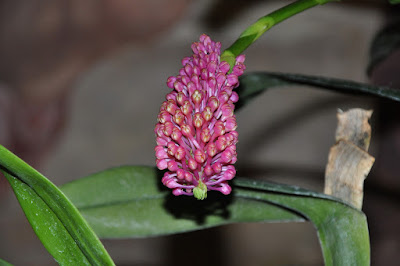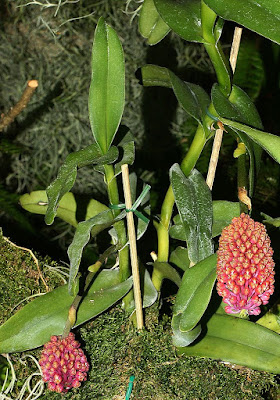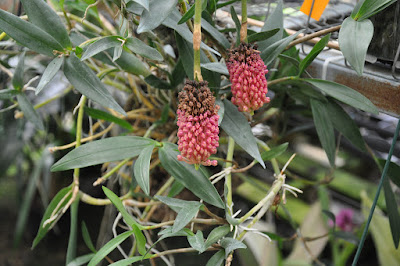Robiquetia cerina is native to Philippines. This orchid grows on the island of Luzon in the provinces of Bataan, Benguet, Bontoc, Camarines, Laguna, Mountain Province and Rizal...
Robiquetia cerina also called as The Waxy Flowered Robiquetia, Malleola merrillii, Robiquetia merrillii, Saccolabium cerinum, is a species of the genus Robiquetia. This species was described by Leslie Andrew Garay in 1972.
IDENTIFY ROBIQUETIA CERINA
Robiquetia cerina is native to Philippines. This orchid grows on the island of Luzon in the provinces of Bataan, Benguet, Bontoc, Camarines, Laguna, Mountain Province and Rizal; on the island of Mindanao in the provinces of Agusan (on the top of Mt. Hilong-hilong) and Bukidnon; on Negros Island in the Negros Occidental province. They grow epiphytically, usually on tree branches and on rocks on steep, open slopes, at altitudes of 350-3200 m.
It is a medium sized, hot to warm growing epiphyte, which reaching 15 cm long, with rather broad, strongly compressed, ancipitous, 15 cm long stems carrying several, leathery, 2 ranked, at right angles to the stem, basally clasping, up to 20 cm long and 3-4 cm wide leaves.
The Waxy Flowered Robiquetia blooms in the fall and winter on a racemose, conical, pendulous, 6 to 10 cm long, successively many flowered inflorescence that has a third of the flowers open at any one time. The small, purple, or purple and yellow, bell-shaped flowers that do not open completely, are about 0.8 cm in diameter. The outer whorls are broadly ovate, concave, with blunt tips and have a length of 0.5 cm and a width of 0.4 cm. The deep concave spine flap is tilted forward, forming the type of hood above the spine. The lateral outer petals curl forward from the base, on the sides of the lip, and then converge at the apex. Almost round flakes of inner whorl are up to 0.5 cm long and wide, curving forward, starting from the base, on both sides of the spine. They have rounded ends that converge and almost touch the prone. The spur-shaped lip is slightly 3-flap, and its side plots are very small.
ROBIQUETIA CERINA CARE AND CULTURE
Cultural information should only be used as a guide, and should be to be adapted to suit you. Your physical location; where you grow your plants, how much time you have to devote to their care, and many other factors, will need to be taken into account. Only then can you decide on the cultural methods that best suit you and your plants.
Light:
Robiquetia cerina needs a light level of 30000-40000 lux. The light should be bright but slightly filtered or scattered, and the plants should not be exposed directly to the sun in the afternoon hours. Strong air movement should be ensured all the time.
Temperature:
This species can be grown in moderate conditions, but also in warm or cool conditions. In summer, the average day temperature is 22-24 ° C, the average night 16 ° C, which gives a daily difference of 6-8 ° C. In winter, the average day temperature is 22-23 ° C, and the night 13-14 ° C, with a daily amplitude of 9-10 ° C.
Humidity:
The Waxy Flowered Robiquetia needs the humidity of almost 90% for most of the year, falling to 85% for several months in winter and early spring.
Substrate, growing media and repotting:
It is probably easier to deal with Robiquetia cerina if they are attached to the tree ferns. However, such plants require high humidity, and during hot and dry weather, they should be watered several times a day.
You can also grow it in shallow hanging pots or baskets with a quick-drying substrate with excellent drainage and good aeration that allows for quick drying after watering. Growers usually use medium granulation of fir bark or pieces of tree fern fiber with the addition of coarse pearlite and / or chopped sphagnum moss, which simultaneously increases the permeability of the substrate and allows the retention of moisture. The addition of charcoal helps to ensure the airiness of the substrate and prevents soda.
The plants should be repotted immediately if the substrate begins to decompose. It's best to do it when new roots start growing. This will allow the plant to adapt to the new substrate in the shortest possible time.
Watering:
In the natural habitat, rainfall in the period from spring to late autumn is very abundant. Average precipitation decreases for 2-3 months in winter and early spring. The plants should be watered abundantly during the period of intensive growth, but ensure perfect drainage so that the ground around the roots is never spread or soggy. In addition to the period of active plant growth, watering should be somewhat limited, however, the substrate should not be allowed to dry out completely.
Fertilizer:
During the active growth, the plants should be fertilized every week 1/4-1/2 of the recommended dose of fertilizer for orchids. From spring to mid-summer you can use fertilizer enriched with nitrogen, switching to phosphorus-enriched fertilizer in late summer and autumn.
Rest period:
Robiquetia cerina need less water in the winter, especially if they grow under the conditions of a dark, short day that occurs in moderate latitudes. However, these plants should never be dried. At the same time as reducing the amount of water, fertilization should be reduced or eliminated until new growths appear and the spring begins to be more abundant.















COMMENTS